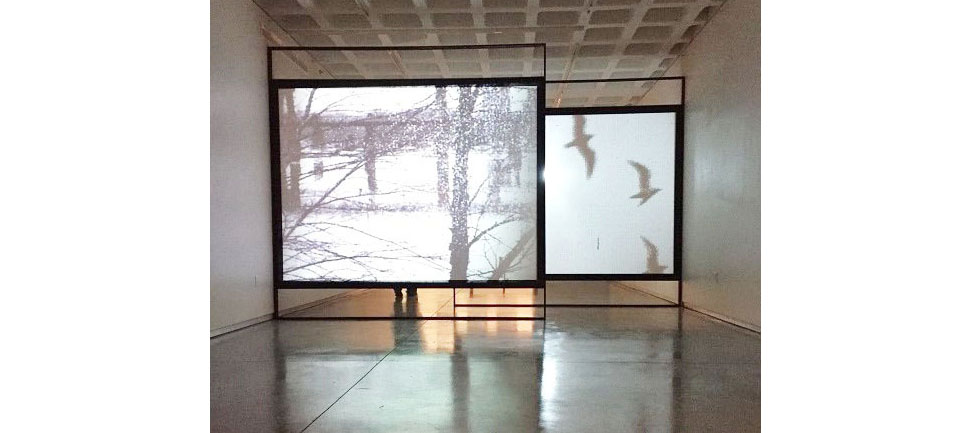
By Stephanie Singer
A new exhibit arrived in the Neil Britton Art Gallery located in the Hofheimer Library on Virginia Wesleyan College’s campus. Enigmatic and wide open to interpretation, this exhibit draws an audience like the sun’s gravity pulls comets from orbit. The artist: Mariam Eqbal. The title: “Amplifications and Measures.”
There will be an opening reception at the Neil Britton Art Gallery on Friday, Feb. 26 at 6:30 p.m. The exhibit will be on display until April 8, 2016.
The artist, Mariam Eqbal, has featured exhibits throughout the United States, along with Canada and England. In 2015, Eqbal won multiple Awards of Merit in the Accolade Global Film Competition. Eqbal will be present at the reception, engaging with the public.
“I [also] work in video, animation, and sound, which further extend into performance and installation,” writes Eqbal on her website. An auditory component enhances “Amplifications and Measures.”
Pure yet strong sounds of nature resonate through the gallery. The pulsing of waves mingles with the rumble of an earthquake. Desert winds howl and whine. A seagull’s cry pierces the air.
These natural sounds could easily pass for industrial noise as well. The pounding of a hammer pairs with the droning of traffic. A fighter jet launches from an aircraft carrier, air rushing over the metal. A steam-driven engine moans as its gears creak.
Every now and then, an instrumental break fades in and out – surreal strings, wonder-inducing woodwinds, and percussion pounding in the background. Brief periods of silence offer time to pause and reflect. Usually at these pauses, people would get bored and leave. But here, the effect mesmerizes.
Eqbal also wrote that she interested in the visualization of evolutionary processes and the abstracted in-betweens of becoming on her website. In animation work, an in-between is a sequence of drawings that fills in the space between two or more poses. “Amplifications and Measures” draws from this concept of in-betweens as it transitions from one theme to the next. Tonal images, simple yet expressive, project onto opaque white screens. Instead of resting on one image, or even one obvious motif, they change. One resembles dark sand blowing across a pale sky. This sandstorm almost completely darkens the sky, before going to back to white.
The white changes to flickering gray rectangles on one vertical edge that resemble antique strips of film. The motion is irregular, yet has a pattern: in and out, up and down, side to side. The rectangles flicker one last time and disappear.
Now, geometric figures appear, hand-drawn on a horizontal plane. These rounded triangles and arcs tremble from side to side. They blink once, then fade into light gray oblivion.
Gray spatters jitter across the screen. These turn into a highway bridge over a river. It’s devoid of human activity, no cars or pedestrians in sight. The photo appears pixelated yet distinct. It jumps to a closer shot of the bridge. Sure enough, it’s abandoned.
The spatters take over yet again. Then they morph into silhouettes of a seagull flock. Their flight seems unstable as the birds shiver in midair.
Continuing on the maritime motif, a row of old beach houses takes the seagull’s place. They shake violently, as if a hurricane-force wind rattles their delicate frames. At last, the beach houses fade away. The sandstorm replaces them, and the sequence begins again.
Eqbal works with both traditional and digital art. According to Eqbal, when traditional and digital media are integrated, it combines the handmade with the automated, the flexible with the constrained, and the unknown with the expected. This idea is present in the exhibit.
Human-built structures, such as beach houses and bridges, juxtapose images of nature, such as seagulls and a sandstorm. The soundtrack could lean either way – does it represent Earth’s natural powers, or the human tendency to shape the world?
The college’s website states that “Amplifications and Measures” depicts the theme of change through repetition. An audience might view the rapidly changing images and sounds as separate. Upon closer examination, they create a cycle and a flow.
With most art and writing, it’s easier to create in the moment. For example, when painting a landscape, visiting the location ensures a better painting. In the case of this exhibit, the opposite proves true. After all, the creation is already so strong.
Keeping that in mind, here are some steps to take. Attend the reception; if you can’t, just visit the Neil Britton Art Gallery. Stay for as much time as desired, the longer the better. Exit the gallery with the creative forces in your heart. Share it with the world.


